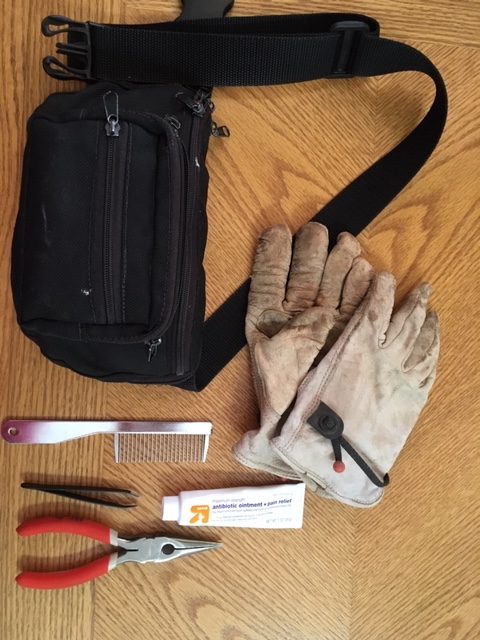Imagine you are out on a walk with your dog, she strays slightly off the path following a good smell and then yelps! As she runs back you see she has a small cholla segment attached to her neck. Ouch! What should you do? Read on to find expert tips to help your pet.
Both cats and dogs can have close encounters with cactuses. The quills become embedded in pets’ skin, paws, tongue, or all of the above. Whether your pet meets a cactus in your yard, or away from home, have the proper tools handy to safely remove the quills. It’s also important to recognize when you will need veterinary assistance.
If the cactus quills are embedded too deeply, are lodged in the oral cavity, or there are just too many for you to remove on your own, by all means, give us a call to schedule an appointment to help! Some pets are just too wiggly, in too much pain, or trying to bite, and sedation at our office will make the cactus quill removal more comfortable and less stressful.
But if your pet picked up just a few quills, or a cholla or prickly pear segment, you may be able to perform first aid yourself.
Know the enemy:
The quills of many species of cactus have microscopic, overlapping scales that function as barbs. (Think: millions of tiny fishhooks!) This design makes it easy for the quill to puncture skin, and much trickier to pull out. (Fun fact: porcupine quills have the same design feature!)
Cholla and prickly pear have evolved so even a light brush against the plant may cause a little segment of the plant to break off (they don’t really ‘jump’) and travel along attached to an animal’s skin. This is one cactus strategy of spreading itself to new areas.
Some cactuses have a second, miniaturized defense system: tiny, hairlike quills called glochids, grouped around the main quills. Glochids are so small they may be more easily felt than seen, especially when you’re trying to find them through a pet’s haircoat.
Which brings us to the first important point in cactus quill removal:
Don’t become the second victim! It may pure instinct when your pet is in pain to try to grab the cactus out with your own hand, but please don’t! Protect your hands first, so you’ll be better able to help your pet. Do your best to keep your pet from pawing at the cactus quills if they’re in her face, or from trying to bite the quills out of any body part (resulting in punctures and quills in the mouth.)

What you’ll need:
(1) thick leather work gloves (most gardening gloves aren’t thick enough)
(2) a small pair of needle-nosed pliers
(3) a metal-toothed dog or cat comb, (with teeth 1/8 ” to 1/4″ apart)
(4) tweezers (get good quality eyebrow tweezers, they’ll work better)
(5) triple antibiotic ointment
Step 1: Put On the Leather Gloves. (Really).
Step 2: Select the best tool for the type of cactus:
A cholla or prickly pear segment, (or any large plant burr for that matter), is easily removed with your metal comb. Slide the teeth between the piece of cactus and your pet’s skin and ‘comb’ it out. Then inspect for any quills left behind.
Larger quills can be removed using your pair of needle-nosed pliers. Grab one quill at a time, as close to the skin as you can, and pull straight out. Stabilize the skin with your other (gloved) hand, otherwise, you’ll be pulling the skin up rather than the quill out. (Remember those tiny barbs!) Don’t squeeze too hard with the pliers as you pull, or you may break the quill off under the skin. Sometimes this can happen no matter how careful you are! (More on what to do if this happens, in a minute).
Tweezers can be used to remove smaller spines or glochids. If you have water handy, get a small bowl of water to rinse quills or glochids off your pliers or tweezers as you go. Apply a small amount of antibiotic ointment (such as Neosporin) to the punctures.
If you accidentally break off a quill or feel some quills left under your dog’s skin, don’t panic.
You may opt to monitor any smaller quills that break off: these may work their way out over time. Any buried quills that continue to bother your pet need to be removed as soon as possible. Large quills lodged under the skin should be evaluated by your veterinarian and may need minor surgery to remove.
Monitor your pet’s punctured skin for any sign of infection, such as swelling, redness, or draining fluid.
The team here at Sabino Veterinary Care is very experienced in cactus quill removal, should you need our help, please do not hesitate to call us!
To your pet’s health!
-Dr. Susan Bertram
What's Next
Call us or schedule an appointment online.
Meet with a doctor for an initial exam.
Put a plan together for your pet.

